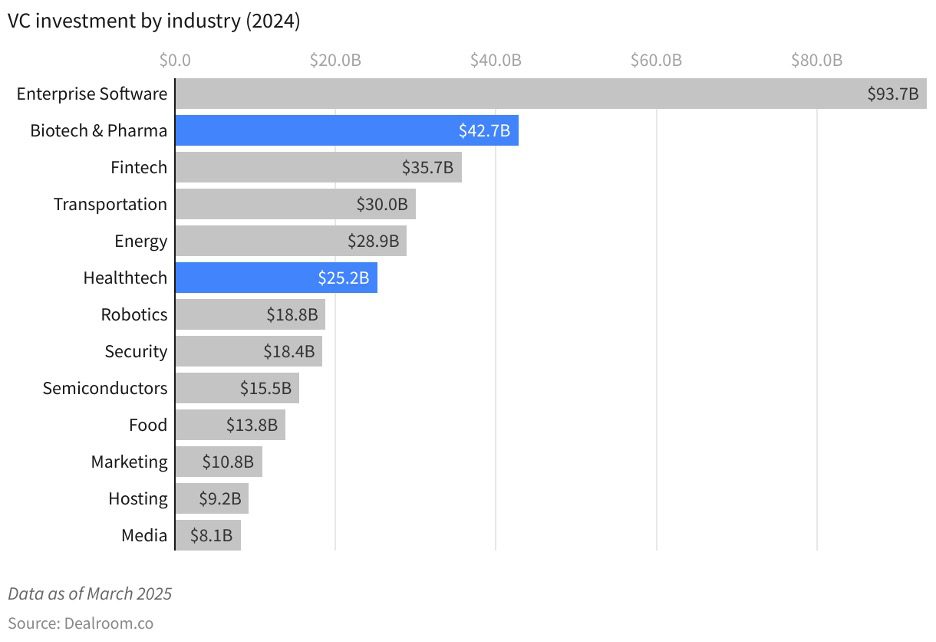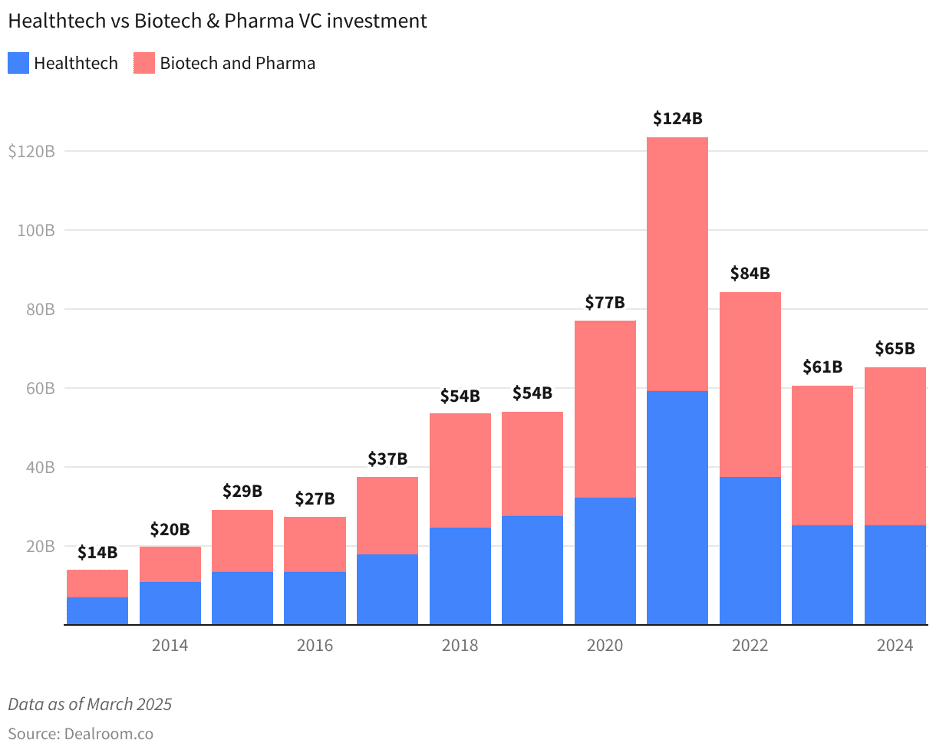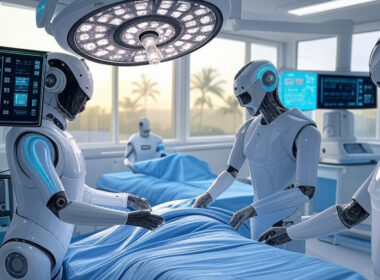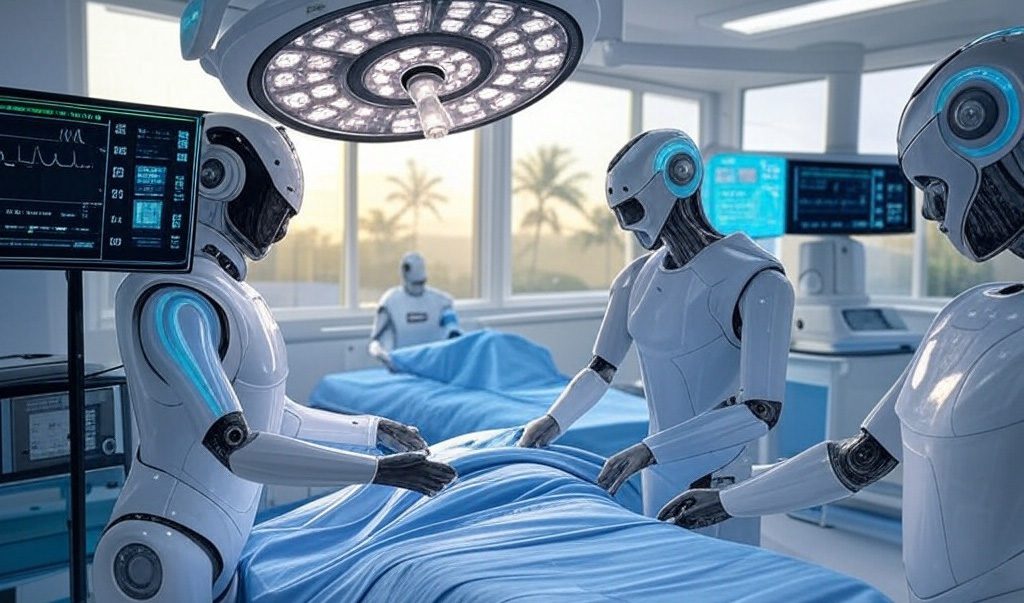Healthcare costs have hit crisis levels.
In 2021 alone, Americans spent a whopping $4.3 trillion on healthcare—equating to nearly $13,000 per person and accounting for 18.3% of the nation’s GDP, according to the Centers for Medicare & Medicaid Services.
Compare that to just a decade ago, when total healthcare spending hovered around $2.9 trillion, and you see a staggering jump of almost 50%.
The trajectory is so steep that by 2030, spending could surpass $6.8 trillion, leaving businesses, government programs, and everyday citizens gasping for relief.
It’s not just the US.
In 2020, global healthcare spending totalled approximately $8 trillion. Of this amount, Europe accounted for $2 trillion, while the United States contributed $3.5 trillion.
This expenditure is expected to increase at a rate exceeding 5% annually – faster than the growth of the overall global economy.
And while 2024 data has not yet been made available, the 5% pace gives us a total of $11-12 trillion based on historical trends and partial data.
Meanwhile, the Centers for Medicare & Medicaid Services projects 2024 to be around $5.15 trillion – on pace again to represent 18% of US GDP.
In other words, if we don’t do something about this healthcare-related financial crisis, the current global debt crisis will burst in spectacular fashion.
This doesn’t even include other financial obligations such as social security.
But there’s hope – if we spend the resources now.
A Glimmer of Hope
In the midst of this budget-busting reality, there’s a rapidly emerging silver lining: a healthcare revolution powered by diagnostics, robotics, and, most importantly, artificial intelligence (AI).
Billions of dollars in venture capital are flooding into companies that promise to transform how we diagnose, treat, and ultimately prevent disease. Think of it like the dot-com boom—but this time, it’s about saving lives and saving us all a fortune in the process.
This isn’t some far-off dream. It’s happening right now on a global scale. And if you want a front-row seat to the future—one that might just protect you from skyrocketing healthcare bills—pay attention.
AI-driven breakthroughs will define the next decade of healthcare, and the stocks of companies leading the charge could skyrocket.
Venture Capital: The Billion-Dollar Lifeblood of Healthcare Innovation
Healthcare isn’t cheap. It’s a trillion-dollar behemoth that drains wallets and government coffers year after year.
But look at what’s happening behind the scenes: venture capital investment in healthcare is at an all-time high.
In 2024 alone, healthcare VC funding soared to a whopping $23 billion—up from $20 billion in 2023—according to Silicon Valley Bank’s 2024 Healthcare Investments and Exits Report.
And according to Dealroom, combined investments in biotech, pharma, and health tech in 2024 were a staggering $68 billion.
That’s more than robotics, fintech, transportation, energy, and even semiconductors.
Take a look:

Total venture capital in health, biotech and pharma peaked at $124B in 2021, up from just under $30B in 2015.

Nearly 30% of all healthcare VC funding has gone straight into AI-driven companies.
Startups like Innovaccer, which raised $275 million to supercharge its AI-powered healthcare data platform, are on the front lines of this transformation. Emerson Collective—spearheaded by one of the most influential names in Silicon Valley—just backed Hippocratic AI with $141 million, aiming to develop AI agents that handle everything from patient triage to follow-up care.
If you’re seeing a pattern, you’re right: venture capitalists have identified healthcare AI as a goldmine, and they’re betting big. In fact, investment across the healthcare spectrum is up 44% since 2020, with AI as the main driver.
Translation: Rising healthcare costs are fueling an investment frenzy—one that could reshape the industry faster than the naysayers ever thought possible.
The AI Trifecta: Diagnostics, Drug Development, and Surgeries
AI isn’t just a fad or a flashy marketing tool. It’s a fundamental game-changer, overhauling every corner of healthcare.
Let’s focus on three key areas.
Diagnostics: Catching Diseases Before They Catch You
When it comes to diagnosing life-threatening conditions like cancer or heart disease, speed and accuracy can mean the difference between life and death. AI-powered imaging tools are already outpacing human specialists at reading X-rays, MRIs, and CT scans. Not only are they faster, but they’re often more precise—potentially saving billions of dollars by preventing misdiagnoses and late-stage interventions.
Companies are using AI to streamline diagnostic workflows, reducing wait times and cutting costs dramatically. Meanwhile, liquid biopsies—simple blood tests that detect cancer—are becoming more powerful with AI at the helm (source: Nature).
And we’re seeing breathtaking innovation (pun intended) from Breath Diagnostics, Inc., which is developing a platform to diagnose diseases with just one single breath test. And when combined with AI, the process has shown “insane accuracy” in a recent study (source: Nature Scientific Reports), highlighting just how fast diagnostics are advancing.
Via Nature:
“…VOCs in exhaled breath were captured by a micro-reactor approach and quantified using mass spectrometry. CT and breath markers were input into a deep-learning autoencoder classifier with a leave-one-subject-out cross validation for nodule classification.
…The CAD system achieved 97.8% accuracy, 97.3% sensitivity, 100% specificity, and 99.1% area under curve in classifying pulmonary nodules.”
Imagine being able to detect diseases with just one breath. Sounds like the future…but it’s closer than ever.
Drug Development: Slashing a Decade into Months
Developing a new drug used to take years—sometimes over a decade—and cost billions. AI is compressing that timeline like never before, sifting through massive data sets to pinpoint promising drug candidates in a fraction of the time. It’s also revolutionizing clinical trials by predicting outcomes and refining patient selection.
No wonder investment in biopharma AI has skyrocketed by 300% since 2023. Companies like Insitro are blazing the trail, using AI to accelerate drug discovery for some of the most devastating diseases on the planet—from Alzheimer’s to cancer.
Surgeries: Robotic Precision Meets Human Ingenuity
In operating rooms worldwide, surgical robots are taking center stage.
But they’re more than glorified mechanical arms—they’re powered by advanced AI that makes procedures safer, faster, and less prone to human error.
Intuitive Surgical, the maker of the da Vinci system, is integrating AI to guide robotic surgery with near-flawless precision. The result is shorter wait times, quicker recoveries, and lower costs for patients and providers alike.
From 8 Weeks to 4 Hours
If you want to see just how fast this transformation is happening, look no further than Hawaii.
You might think of it as a blissful tourist destination—but right now, it’s also a proving ground for some of the most advanced healthcare innovations on the planet.
Hawaii’s new Advanced Lung Institute is a perfect example.
Thanks to cutting-edge technology and AI-driven techniques, surgery wait times could plummet from an excruciating 8 weeks to just 4 hours, according to Hawaii’s new Advanced Lung Institute. Let that sink in: a procedure that used to require two months of anxious waiting can now be done in a single afternoon.
And it’s not just about lung procedures.
Across the Hawaiian Islands, telemedicine and predictive analytics are stepping up to bridge critical gaps in care—especially in remote areas like Kauai or Molokai, where travelling to Honolulu for specialized treatment can be a logistical nightmare.
By identifying at-risk patients early and coordinating resources more efficiently, these AI-based solutions are slashing costs and saving lives in one of the most geographically challenging healthcare environments in the United States.
The Profit Opportunity
The healthcare AI market is expected to grow at a scorching compound annual growth rate (CAGR) of over 40% for the next decade. It’s no wonder stocks like Intuitive Surgical have continued to trend higher, tripling in share value over the last five years.
Why? Because rising healthcare costs aren’t going away—and these companies are providing solutions that drastically cut expenses while improving patient outcomes. Think of it as the perfect storm for investors: a massive market in desperate need of innovation, paired with cutting-edge tech that finally delivers real results.
And let’s be honest: when you can reduce an 8-week surgical backlog to a same-day procedure, the entire industry takes note. As these breakthroughs move from pilot projects to mainstream adoption, you can bet the biggest winners will be the early investors in AI-driven healthcare.
Don’t Be Fooled
But there is a caveat. While AI in healthcare is revolutionary, you should be cautious of smaller startups that heavily promote AI as their core strength. Effective AI relies on vast amounts of data—the more, the better.
Take Tesla, for example. Even with its unmatched real-world data, Tesla has yet to master autonomous driving fully.
So, when evaluating AI health companies, prioritize those with a solid foundation that doesn’t depend solely on AI for success—because in fields like diagnostics, the quality of the outcome depends on the quality of the input.
Seek out technologies that function effectively without AI, where AI serves as an enhancement rather than the entire solution.
In AI-driven diagnostics, tools like medical imaging analysis (e.g., for detecting cancer in X-rays or MRIs) rely heavily on the quality of input data. For instance, if an AI model is trained on a dataset of high-resolution, well-labelled images from diverse patient populations, it can accurately identify abnormalities like tumours or fractures.
However, if the input data is poor—say, blurry images, incomplete patient histories, or a biased dataset lacking diversity (e.g., only images from one demographic)—the AI might miss subtle signs of disease or produce false positives. A real-world example is the use of AI in detecting diabetic retinopathy: models trained on clear retinal scans with detailed annotations outperform those fed low-quality scans or unverified labels, directly impacting diagnostic accuracy.
In robotic-assisted surgery, AI systems like the da Vinci Surgical System depend on precise input from sensors, cameras, and preoperative imaging to guide instruments.
If the input is high-quality—sharp 3D visuals, accurate patient anatomy mapping, and real-time feedback from the surgical field—the AI can enhance a surgeon’s precision, reducing tissue damage and improving outcomes. Conversely, if the input is flawed (e.g., distorted images due to equipment malfunction or outdated scans that don’t reflect current tumour growth), the AI might misguide the robot, leading to errors like cutting healthy tissue or missing critical areas. The success of AI in minimally invasive procedures, such as prostatectomies, hinges on this input fidelity.
Then there’s drug discovery and personalized medicine, where AI models predict how compounds interact with biological targets or tailor treatments to individual patients.
For example, in pharmacology, AI systems like those used by companies such as BenevolentAI analyze vast datasets of molecular structures, clinical trial results, and patient genetics. If the input data is comprehensive and accurate—high-quality genomic sequences, detailed trial outcomes, and well-documented side effects—the AI can identify promising drug candidates or optimize dosages effectively. But if the input is spotty, such as incomplete patient records, contaminated lab samples, or poorly curated chemical libraries, the AI might suggest ineffective drugs or overlook toxic interactions.
A case in point is AI-driven pharmacogenomics: accurate genetic profiles lead to better predictions of drug response, while errors in sequencing data can result in harmful prescriptions.
In each domain, garbage in equals garbage out. High-quality, well-structured input data empowers AI to deliver reliable, life-saving results, while subpar inputs undermine its potential and risk patient harm.
Be extremely wary of the healthcare companies that rely only on AI.
Conclusion
Rising healthcare costs are here to stay—that’s just a fact of modern life. But that same pressure is fueling a revolution that could change the way we approach medicine forever. From AI-powered diagnostics catching cancer earlier to robotic surgeons minimizing hospital stays, the face of healthcare is undergoing a radical shift.
And the investment case? It’s tough to overstate. We’re staring down a once-in-a-generation chance to put your money into a sector that’s not only on the cusp of explosive growth but also poised to save lives and livelihoods. That’s a win-win that doesn’t come along very often.
The bottom line: whether you’re concerned about your own medical bills or looking for the next big thing to supercharge your portfolio, AI-driven healthcare is the space to watch. It’s not just a bet on technology; it’s a stake in a healthier, more cost-effective world—and that’s the kind of investment that can pay dividends far beyond the balance sheet.













Interesting that healthcare costs in the US could be cut by at least 30% if a universal health care system were put in place – as exist in most civilized countries. A system where the health insurance system is one government department that sets all medical charges, pays all medical bills and does away with all the current expensive bureaucracy where clerks are tasked with finding ways to reject claims from health insurance customers. As long as health care is dictated by charging whatever the market will accept, the rapidly rising cost of health insurance will rocket upwards. Insurance companies, doctors, hospitals and the drug industry will spend billions lobbying to make sure no one interferes with their profits. Lobbying is just a cost of doing business.
What a great product. The sick and those on the verge of death will pay whatever they are charged to avoid pain and death, A few hundred thousand bankruptcies every year s is almost irrelevant to the healthcare industry who are able to raise their prices to offset these losses by customers who were unable to pay what they were billed.
You are totally ignoring what the Trump destruction of the US government and its democracy will do to government care and control of the justification and funding, government and private, for the developments that you are suggesting.
Ai has far too quickly become the catch phrase panacea for everything and anything. So far, what i see is for a way to make computers the new sweat shops and rob people of more and more interaction and unity. Ai is or will be a “shell” that others use to obfuscate and manipulate…kind of like a muppet, so real and interactive that you forget there is a couple of hands and a brain manipulating it for your entertainment. Musk said it years ago, “Ai poses an existential threat”. We need more doctors and nurses and physical support systems for them to heal and care for people, not Ai.